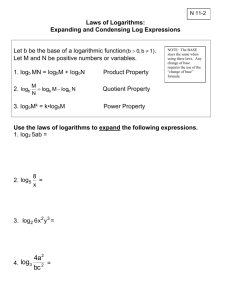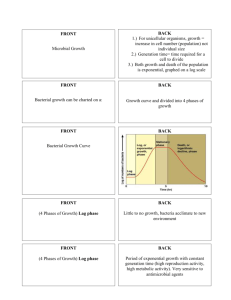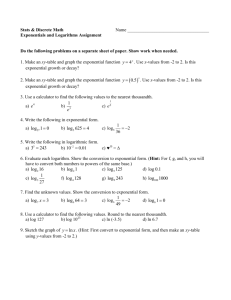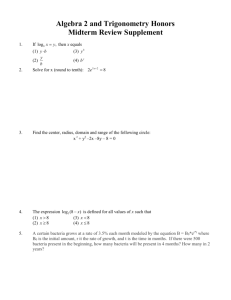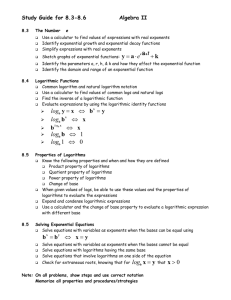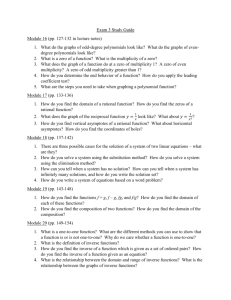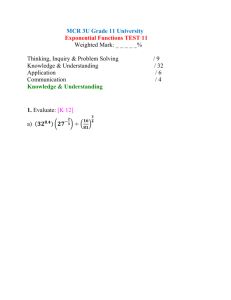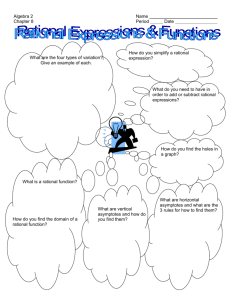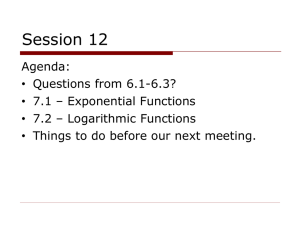Test 3 Review
advertisement
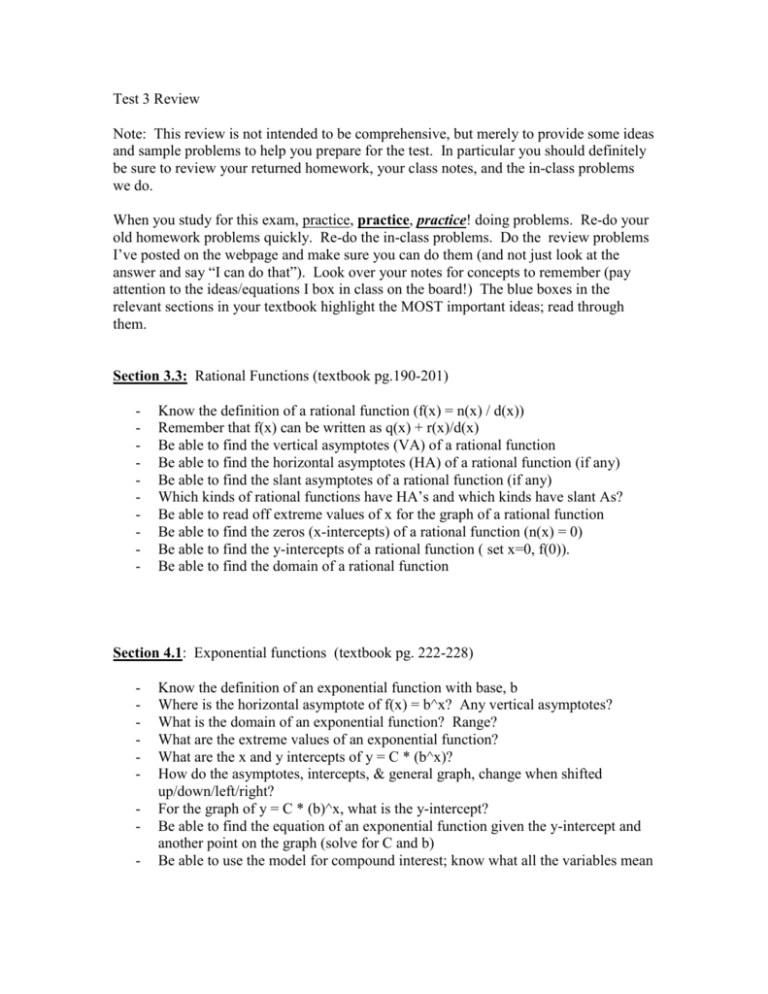
Test 3 Review Note: This review is not intended to be comprehensive, but merely to provide some ideas and sample problems to help you prepare for the test. In particular you should definitely be sure to review your returned homework, your class notes, and the in-class problems we do. When you study for this exam, practice, practice, practice! doing problems. Re-do your old homework problems quickly. Re-do the in-class problems. Do the review problems I’ve posted on the webpage and make sure you can do them (and not just look at the answer and say “I can do that”). Look over your notes for concepts to remember (pay attention to the ideas/equations I box in class on the board!) The blue boxes in the relevant sections in your textbook highlight the MOST important ideas; read through them. Section 3.3: Rational Functions (textbook pg.190-201) - Know the definition of a rational function (f(x) = n(x) / d(x)) Remember that f(x) can be written as q(x) + r(x)/d(x) Be able to find the vertical asymptotes (VA) of a rational function Be able to find the horizontal asymptotes (HA) of a rational function (if any) Be able to find the slant asymptotes of a rational function (if any) Which kinds of rational functions have HA’s and which kinds have slant As? Be able to read off extreme values of x for the graph of a rational function Be able to find the zeros (x-intercepts) of a rational function (n(x) = 0) Be able to find the y-intercepts of a rational function ( set x=0, f(0)). Be able to find the domain of a rational function Section 4.1: Exponential functions (textbook pg. 222-228) - Know the definition of an exponential function with base, b Where is the horizontal asymptote of f(x) = b^x? Any vertical asymptotes? What is the domain of an exponential function? Range? What are the extreme values of an exponential function? What are the x and y intercepts of y = C * (b^x)? How do the asymptotes, intercepts, & general graph, change when shifted up/down/left/right? For the graph of y = C * (b)^x, what is the y-intercept? Be able to find the equation of an exponential function given the y-intercept and another point on the graph (solve for C and b) Be able to use the model for compound interest; know what all the variables mean Section 4.2: Natural Exponential functions (textbook pg. 235-244) - - What is a natural exponential function? What is e? Where is the horizontal asymptote of f(x) = e^x? Any vertical asymptotes? What is the domain of a natural exponential function? Range? What are the extreme values of a natural exponential function? What are the x and y intercepts of y = C * (e^x)? How do the asymptotes, intercepts, & general graph, change when shifted up/down/left/right? For the graph of y = C * (e)^x, what is the y-intercept? Be able to use the model for continuous compound interest; know what all the variables mean. How does this model differ from the compound interest equation in Section 4.3? Newton’s Law of Cooling: Be able to use this model and solve for a variable; know what all the variables mean. Section 4.3: Inverse functions (textbook pg. 249-257) - - Be able to check if the functions, f(x) and g(x) are inverse functions or not ( If f and g are inverses, then BOTH f(g(x) = x for x in domain of g, AND g(f(x)=x for x in domain of f) What do the graphs of a function and its inverse look like? (Reflection about y=x What is a one-to-one function? What does it say about the inverse of f(x)? How can you tell if a function is one-to-one? (Horizontal line test) How can you tell if a function has an inverse or not? Do all functions have inverses? Be able to find the inverse of a function, f(x). (Set f(y) = x and solve for y); be able to do these for rational functions as well (math is trickier – check your inclass notes, or pg. 256 of textbook). Section 4.4: Logarithmic functions (textbook pg. 261-268) - How is f(x) = b^x related to g(x) = logb(x) ? What is the domain of g(x) = logb(x) ? How does this change if you have a graph of y = = logb(ax + c)? What is logb(0)? logb(1)? How do you find the x-intercept of a logarithmic function? (Hint: you need to set something = 0 and solve for x). Find the y-intercept? What base is ln(x)? log(x)? PROPERTIES YOU WILL HAVE TO KNOW COLD (MEMORIZED WELL): o If bp = N, then N = logb(p) o logb(PQ) = logb(P) + logb(Q) o logb(P/Q) = logb(P) - logb(Q) o logb(P^r) = r logb(P) log c (x) ln( x) log( x) o logb(x) = = = (Change of Base) log c (b) ln( b) log( b) o logb(b) = 1 o logb(b^x) = x - Be ableto expand logarithmic functions using these properties Be able to compress a bunch of separate log functions into one log function Section 4.5: Solving logarithmic and exponential functions (textbook pg. 273-279) - Be able to use the properties above in Section 4.4 to solve for x in exponential and logarithmic functions. Some examples (see textbook Section 4.5 for solutions): Solve for x: 1) 3^x = 81 1 2) ( ) 3x 8 2 2 3) 4ex 38 4) 2(3x ) 6 40 5) e 2x 7 5 6) log6(2x) = 3 7) 3 + 2log4(x) = 8 8) log(x) + log(x-3) = 1 9) log(x) + log(x-15) = 2 Here are some more practice problems: 1 x2 . Find the zeros and 5x x 2 6 y-intercepts. What is the domain? Graph this function and label all intercepts and asymptotes. - Write out the equations for the asymptotes of f ( x) - Give me an example of a function with a slant asymptote; A function with only a horizontal (no slants) asymptote? - Review workbook pg. 123-124 homework problems, and Section 3.3 HW probs. - Let f ( x) 3b x ( b>1 ) and g ( x) log 3 ( x 5) 7 . For each of the following properties determine which (if either) of f (x) and g (x ) have this property: 1. 0 is in the domain 2. 0 is in the range 3. The function has a zero 4. The function has a vertical asymptote 5. The function has a horizontal asymptote 6. The function is one to one 7. The function has domain all real numbers 8. The function has range all real numbers 9. The function is increasing everywhere 10. The function is decreasing everywhere
